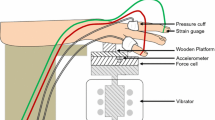Summary
Twenty three patients with hand-arm vibration exposure and diagnosed vibration syndrome were given a thorough clinical and neurophysiological examination, together with finger strain gauge plethysmography. Eleven of the patients were forest workers regularly using chain saws (low frequency vibration exposure), and twelve were metal grinders (higher frequency vibration exposure). Both groups had significantly lower finger blood pressures than healthy controls, and comparisons between the groups indicated that the mean values tended to be lower in the grinders. The findings suggest that hand-arm vibration exosure is associated with obstructive changes in the distal arteries of the fingers, and that vibration frequency is one of the factors determining the severity of the changes and the time of onset of the symptoms.
Similar content being viewed by others
References
Ashe WF, Cook WT, Old JW (1962) Raynaud's phenomenon of occupational origin. Arch Environm Health 5:333–343
Harai M, Nielsen SL, Lassen NA (1976) Blood pressure measurements of all five fingers by strain gauge plethysmography. Scand J Clin Lab Invest 36:627–632
Juntunen J, Matikainen E, Seppäläinen A-M, Laine A (1983) Peripheral neuropathy and vibration syndrome. A clinical and neurophysiological study of 103 patients. Int Arch Occup Environ Health 52:17–24
Klimkovà-Deutschova E (1966) Neurologische Aspekte der Vibrationskrankheit. Arch Gewerbepathol 22:297–305
Lukás E, Kuzel V, Nedvikova H (1977) Vergleich der Untersuchungsergebnisse der Leitungsgeschwindigkeit in den motorischen und sensitiven Fasern des N. Ulnaris und N. Medianus bei Personen mit professioneller oder nicht professioneller Vasoneurose. Int Arch Occup Environ Health 38:283–294
Matikainen E (1982) Diabetic neuropathy. Clinical, electrophysiological, and histopathological studies. Academic disseration, University of Helsinki
Seppäläinen AM (1972) Peripheral neuropathy in forest workers. A field study. Work Environm Health 9:106–111
Seppäläinen AM, Starck J, Härkönen H (1986) High-frequency vibration and sensory nerves. Scand J Work Environ Health 12:420–422
Starck J (1984) Characteristics of vibration, hand grip force, and hearing loss in vibration syndrome. Publications of the University of Kuopio, 4
Starck J, Färkkilä M, Aatola S, Pyykkö I, Korhonen O (1983) Vibration syndrome and vibration in pedestal grinding. Br J Ind Med 10:426–433
Taylor W, Pelmear PL, Pearson JCG (1975) Vibration-induced white finger epidemiology. In: Taylor W, Pelmear PL (eds) Vibration white finger in Industry. Academic Press, London
Author information
Authors and Affiliations
Rights and permissions
About this article
Cite this article
Matikainen, E., Leinonen, H., Juntunen, J. et al. The effect of exposure to high and low frequency hand-arm vibration on finger systolic pressure. Europ. J. Appl. Physiol. 56, 440–443 (1987). https://doi.org/10.1007/BF00417772
Accepted:
Issue Date:
DOI: https://doi.org/10.1007/BF00417772



